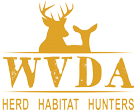2 Buck Limit for WV - Make the Second One Count!
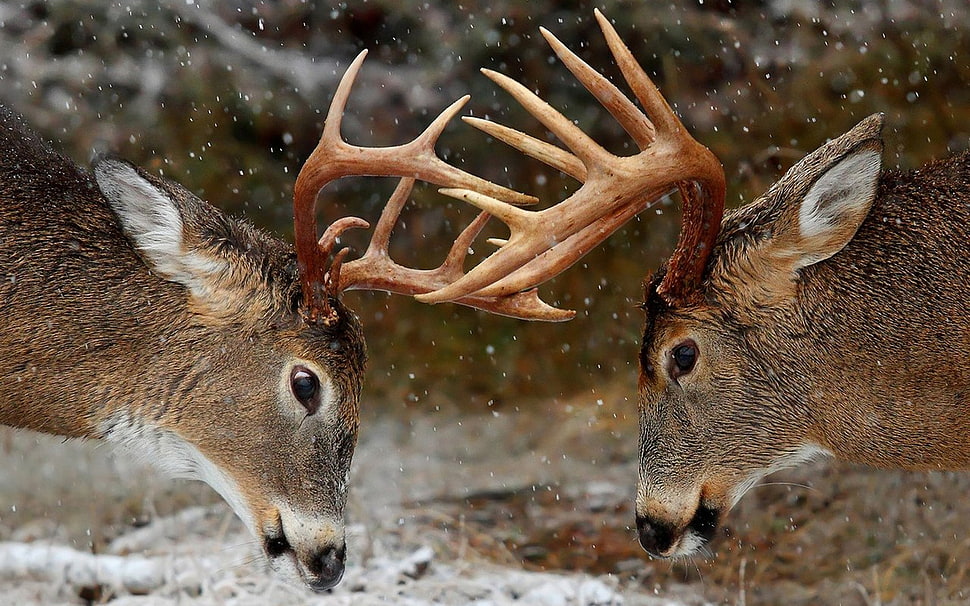 |
The following is the West Virginia Deer Association position statement in favor of lowering the buck limit in WV.
The Proposal
On April 23, 2023 at Pipestem State Park the WV Natural Resources Commission will vote on a proposal to reduce the annual antlered deer bag limit from three (3) to two (2) bucks per year in West Virginia. The proposal, if adopted, would see the annual antlered deer bag limit for all deer seasons combined be reduced from 3 antlered deer to 2 antlered deer starting with the 2024-2025 deer seasons. No changes to antlerless deer bag limits would occur under the proposal and additional class N antlerless tags will remain available for purchase on a county by county basis as needed per WVDNR biologists recommendations. In support of their decision making for this vote the Natural Resources Commission is asking that you provide your opinion on reducing the buck limit to two in the Sectional Meeting Questionnaire. These questionnaires can be filled out in person at one of the Sectional Meetings being held throughout the state on March 13th & 14th OR they can be mailed in as long as they are received by April 3, 2023.
The Goal
Be the best West Virginia we can be and improve deer hunting opportunities for all hunters! The objective is to join West Virginia in the national trend of reducing buck bag limits and shift management focus on quality rather than quantity. By reducing pressure on bucks and balancing the harvest a more natural doe to buck ratio and an older more natural age structure is expected to result. Bottom line…hunters should expect to see more older-aged bucks with larger antlers and more intense rut activity, with improved overall likelihood of being successful at getting a buck.
Buck Limits vs. Antler Restrictions
Why are we advocating for a buck limit rather than just going all in for some sort of a point or spread antler restriction? Not to risk turning this into a book we'll focus on just a couple issues here. Unless you're taking it to the trophy management extreme, antler restrictions (whether point, spread or otherwise) are designed to protect a majority of the the yearling age class from over harvest. You see this approach in states like PA where they already had a one buck limit but, due to high hunter density and harvest pressure, they were left with no other tool than point restrictions to combat the intense yearling harvest they were experiencing. While we believe there is room for improvement in our data collection there is currently no biological evidence to suggest that this is a wide scale problem in WV. Our other concern with antler restrictions is the potential impact to the perceived quality of the standing crop of bucks due to high grading. While the recent science suggests that it is nearly impossible to influence the genetics in a wild free ranging deer herd there can still appear to be a "negative" population impact from removing the highest potential bucks at a younger age. Also, we understand that some hunters simply do not care what size the rack is on a buck and there needs to be room enough for them under this tent as well.Our preference is to utilize limit changes for these reasons.
WV Hunter Survey
In 2019 the WVDNR contracted Southwick & Associates to conduct a hunter opinion survey on the statewide annual antlered deer harvest limit in WV. Southwick is a an independent market research and economics firm, specializing in the hunting, shooting, sportfishing, and outdoor recreation markets. The WVDNR has utilized their services multiple times in the past as have many other fish & wildlife agencies over the last 30+ years. Below is an excerpt from their report summarizing the results of the survey questioning specific to hunter opinions on buck limit reduction in WV:
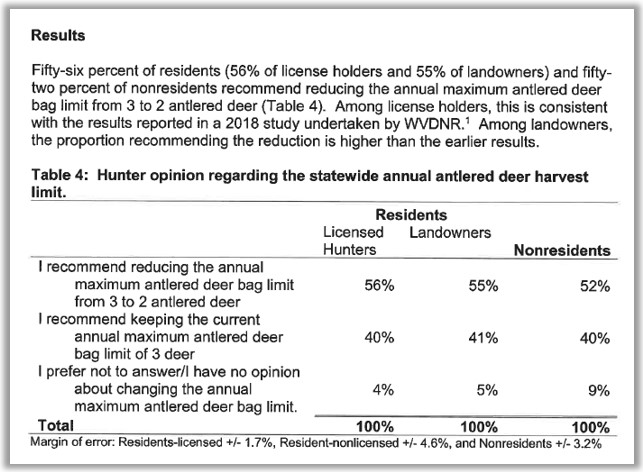 |
The results in the table above are the most accurate scientifically obtainable summary of hunter opinions regarding buck limit reduction. As you can see a majority of licensed hunters, landowners and even non-residents (contrary to expectations) are in favor of reducing the buck limit to 2.
Impacts to Antlerless Harvest
One of the expectations of reducing harvest pressure on the antlered segment of the herd is that there will be a resulting increase in harvest pressure on the antlerless segment to fill the gap. This is a reasonable expectation and was shared publicly in a statement to our Natural Resources Commission by Kip Adams, Wildlife Biologist & Conservation Director for the National Deer Association. We are also expecting a decrease in the buck fawn component of the antlerless harvest as a result of hunters being more selective as they observe their targets more closely. These expectations are, quite frankly, up in the air. The great thing about the way our class N antlerless system is structured is that WVDNR Biologists have the ability to fine tune doe harvest at a much more granular level than is possible in other states. We are confident in their ability to adjust rapidly in order to keep population levels on target, which is something our guys do very well.
Financial Impact
According to an analysis done in 2019 the potential impact/losses from dropping the third tag stands at about $220k per year (projected from 1995 data). This may sound like a lot to the average sportsman but when compared to the overall WVDNR budget ($107,009,363.18 in 2021 expenditures) it's miniscule. In fact, over just the past few years, we've seen the WVDNR investment funds & savings accounts balloon by over $32 million according to the annual reports. Their total balance is currently standing at about $159.5 million.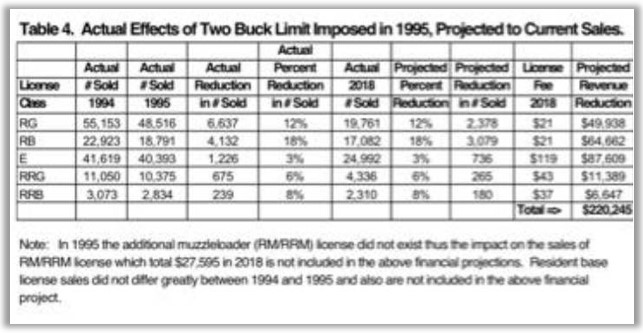 |
TN as a Case Study
Below are some results that are coming out of Tennessee, which went from a 3 to a 2 buck limit in 2015-16 season. The Volunteer State is seeing good increases in older and larger bucks, a decrease in yearling buck harvest and an improved success rates as a result of their limit reduction. It’s important to note that the third buck tag in TN was utilized with about the same frequency as is currently is in WV (~1% of successful hunters). The lesson learned from the TN experience is that it really isn’t about how many hunters use the third tag, it boils down to the decision a hunter makes with their second tag when there isn’t another one to fall back on.
Resulting Buck Age Distribution in TN
We tend to get criticized for summarizing data ourselves so here it is straight from the biologists at the TWRA... A line graph showing the proportional changes in harvested buck age classes over each season year (years outlined in the red box signifies when TN transitioned from a 3-buck bag limit to a 2-buck bag limit).
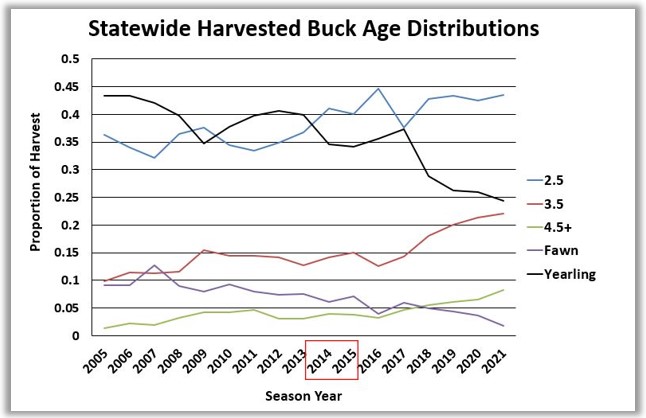 |
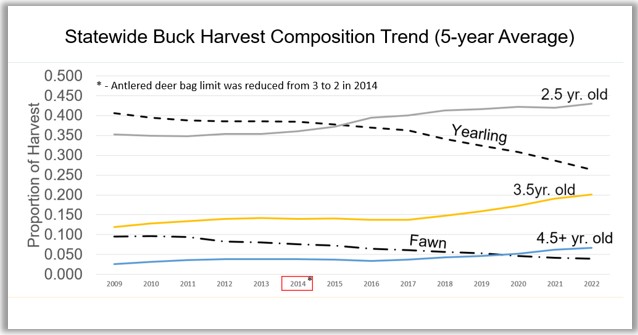 |
A quick look at the above graphs and you'll quickly notice a significant reduction in the % of yearling bucks in the harvest while, at the same time a significant increase in the % of 3.5 year old bucks in the harvest. Also of note is a modest increase in % of 4.5 year old and decrease in % of buck fawns in in the harvest. The 5-year average trendlines are showing favorable response at every metric. Given that we're seeing shifts 5-10 fold beyond what the number of 3rd buck tags going unfilled one can only conclude that there is a shift in decision making and selectivity as a result of the reduced bag limit. Fewer tags = more selective hunters.
Increased Success Rates in TN
We have long held that the removal of the third buck tag will result in a change on the part of some hunters in deciding what to harvest with the second tag, resulting in additional bucks available later in the season to a broader range of hunters. This assumption has held true in the TN experience. The impact was noticed immediately in the first season after reduction. According to TWRA Biologist Chuck Yoest the number of people who killed at least one deer in the first year increased by more than 4,400 over the previous year."That's really cool," he said. "Some people were concerned that reducing the [buck] limit would reduce the opportunity. But that doesn't seem to be the case." In fact, a look back of the TN's success data conducted through the 2021 season revealed a consistent 8-10% increase in the number of hunters successful in getting a buck. Thousands of hunters are now able to harvest a buck that would have otherwise been left out in the cold eating tag soup prior to the limit reduction.
Shift in Hunter Attitude in TN
In the Summer of 2014 the Tennessee Wildlife Federation conducted a wide ranging survey of deer hunters in the state. A majority of the hunters surveyed, 56 percent, said they want to see the bag limit stay at three. Coming in second was reducing the bag limit to two (24 percent) and third was reducing the bag limit to one (14 percent). On the other end of the spectrum, 6 percent would like to see the bag limit increased. Reducing the bag limit from 3 to 2 certainly was not favored by a majority of TN sportsmen but later that year the Tennessee Fish & Wildlife Commission voted to reduce the limit for the 2015-16 season regardless, and they've stuck to their guns. Has there been a shift in the attitude of TN hunters toward the 2 buck limit now that they have several years under their belt experiencing it's impacts? Below is a table from their recent statewide survey on attitudes and opinions of hunters here in Tennessee concerning their perceptions of the current antlered deer limit:
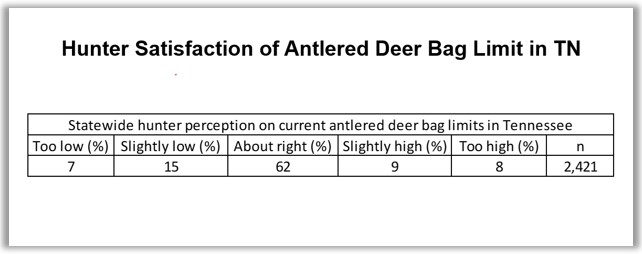 |
So, now that TN has 7 or so years under it's belt with the 2 buck limit we see that there has been a dramatic flip flop from 56% opposed to a 2 buck limit just prior to reduction to a current 62% of hunters statewide saying that a 2 buck limit is about right. It's also interesting that only 22% of hunters now want to see a higher limit.
The Naysayer Arguments
Hunters will lose opportunity!
False. First of all, please define the word opportunity. Are we stuck in the 80's where the word opportunity in deer hunting simply means if it's brown it's down? We don't think that's where the majority of hunters are today. Even if that were the case you're missing the lesson in TN's success data. More hunters have the opportunity to get a buck during the season, more hunters have the opportunity to hunt a mature buck, more hunters have the opportunity to hunt areas with more intense rut activity, more hunters have the opportunity to harvest a doe. If you want to make opportunity the focus of your opposition you've lost this one for sure.
The 2 buck limit is just a stepping stone to get to their ultimate goal of a one buck limit.
False. While it is true that we believe the limit reduction to 2 bucks is a step in the right direction to improving overall herd structure and hunting opportunities, we are not in favor of a one buck limit. The reasons for this are twofold. First, this is not a financially feasible proposition given the current license structure and budget demands. Second, there is no direct scientific survey evidence that we can point at to argue that this is something a majority of hunters in WV want. As an association of deer hunters we have to look to draw the biggest tent around our deer hunting community as is possible. A two buck limit does that.
Hardly anyone kills 3 bucks, you're only protecting a few bucks.
False. First of all, you're really making a great case that there's no need for the 3rd tag with this statement. Secondly, the number of hunters that took 3 bucks in 2021 was 853 and while it appears valid and rather powerful on the surface to simply say that only 1.3% of hunters use the third tag it really isn't...because math...and because people. Recall that TN was at 1% just prior to their reduction and has seen significant improvements. Rather than looking at it terms of tags though, what percentage of the overall buck harvest is potentially impacted? Once you factor in potential decision changes on the remaining second tag in addition to removal of third tag harvests then you quickly see that ~26% of the buck harvest in 2021 could have been impacted either directly (3rd tag) or indirectly (decision change). Increased selectivity on the part of hunters is a reasonable assumption, especially when you look at TN where they have had 5-10 fold improvements beyond the mere 1% potential presented at face value.
The DNR will lose too much money, there will have to be cuts.
False. Actually, this statement lands more in the neighborhood of insulting. The potential impact/losses from dropping the third tag stands at about $220k per year. This may sound like a lot to the average sportsman but when compared to the overall WVDNR budget ($107,009,363.18 in 2021 expenditures) it's chicken scratch. In fact, over just in the past few years, we've seen the WVDNR investment funds/savings balloon by over $32 million according to the annual reports with a total balance standing at $159.5 million. To say that there would be any impact to personnel, law enforcement or any other agency programs is disingenuous at best.
TN Deer Registry entries are down, they have fewer big bucks now!
False. This one is pretty ridiculous. Not that book entries are really the goal here but it is rather disingenuous or downright deceitful to make this argument, especially when you know all the facts and how the registry system works. To point to a pandemic year with reduced entries when you know that in person scoring was very limited and events with registry scoring availability were canceled. This was first brought up in 2021 and at the time there were only somewhere around a dozen entries for 2021 at the time and 2020 was somewhere in the 50 range. Sounds like the sky is falling, but wait..doesn't it take a 60 day drying period, aren't we waiting a year to get our taxidermy back, when is the next event where a scorer is available? You bet it does. Check the registry today and you'll see they're up to 86 entries for 2020 and 54 entries for 2021 and those numbers just keep going up over time as guys bring those mounts in to the table.
False. First of all, please define the word opportunity. Are we stuck in the 80's where the word opportunity in deer hunting simply means if it's brown it's down? We don't think that's where the majority of hunters are today. Even if that were the case you're missing the lesson in TN's success data. More hunters have the opportunity to get a buck during the season, more hunters have the opportunity to hunt a mature buck, more hunters have the opportunity to hunt areas with more intense rut activity, more hunters have the opportunity to harvest a doe. If you want to make opportunity the focus of your opposition you've lost this one for sure.
The 2 buck limit is just a stepping stone to get to their ultimate goal of a one buck limit.
False. While it is true that we believe the limit reduction to 2 bucks is a step in the right direction to improving overall herd structure and hunting opportunities, we are not in favor of a one buck limit. The reasons for this are twofold. First, this is not a financially feasible proposition given the current license structure and budget demands. Second, there is no direct scientific survey evidence that we can point at to argue that this is something a majority of hunters in WV want. As an association of deer hunters we have to look to draw the biggest tent around our deer hunting community as is possible. A two buck limit does that.
Hardly anyone kills 3 bucks, you're only protecting a few bucks.
False. First of all, you're really making a great case that there's no need for the 3rd tag with this statement. Secondly, the number of hunters that took 3 bucks in 2021 was 853 and while it appears valid and rather powerful on the surface to simply say that only 1.3% of hunters use the third tag it really isn't...because math...and because people. Recall that TN was at 1% just prior to their reduction and has seen significant improvements. Rather than looking at it terms of tags though, what percentage of the overall buck harvest is potentially impacted? Once you factor in potential decision changes on the remaining second tag in addition to removal of third tag harvests then you quickly see that ~26% of the buck harvest in 2021 could have been impacted either directly (3rd tag) or indirectly (decision change). Increased selectivity on the part of hunters is a reasonable assumption, especially when you look at TN where they have had 5-10 fold improvements beyond the mere 1% potential presented at face value.
The DNR will lose too much money, there will have to be cuts.
False. Actually, this statement lands more in the neighborhood of insulting. The potential impact/losses from dropping the third tag stands at about $220k per year. This may sound like a lot to the average sportsman but when compared to the overall WVDNR budget ($107,009,363.18 in 2021 expenditures) it's chicken scratch. In fact, over just in the past few years, we've seen the WVDNR investment funds/savings balloon by over $32 million according to the annual reports with a total balance standing at $159.5 million. To say that there would be any impact to personnel, law enforcement or any other agency programs is disingenuous at best.
TN Deer Registry entries are down, they have fewer big bucks now!
False. This one is pretty ridiculous. Not that book entries are really the goal here but it is rather disingenuous or downright deceitful to make this argument, especially when you know all the facts and how the registry system works. To point to a pandemic year with reduced entries when you know that in person scoring was very limited and events with registry scoring availability were canceled. This was first brought up in 2021 and at the time there were only somewhere around a dozen entries for 2021 at the time and 2020 was somewhere in the 50 range. Sounds like the sky is falling, but wait..doesn't it take a 60 day drying period, aren't we waiting a year to get our taxidermy back, when is the next event where a scorer is available? You bet it does. Check the registry today and you'll see they're up to 86 entries for 2020 and 54 entries for 2021 and those numbers just keep going up over time as guys bring those mounts in to the table.
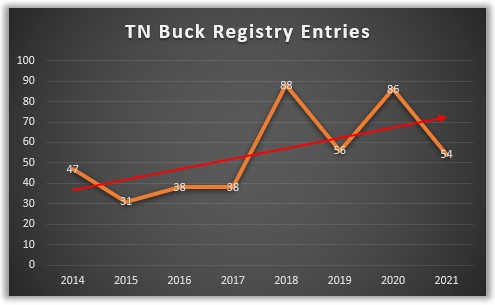 |
There's not going to any biological impact.
False. If your position is an assumption that there is not going to be any biological impact, positive or negative, then it's worth giving this a shot to see if we do fall in the same regard as some of our peers like TN. We find it unhelpful to make assumptions without any scientific testing of their validity, especially when there is little risk in doing so and a body of supporting evidence from others who have taken this path that there is a potential for significant improvement in experiences and opportunity with such a modest change.
Conclusion
The West Virginia Deer Association supports reducing the annual maximum buck harvest limit from 3 to 2 bucks per year. This is a modest change with the potential for a significant positive improvement to deer hunting opportunities in WV with little to no negative impacts. Our goal is to create quality deer with a healthy and more natural herd structure. Lowering the buck limit is not a one stop shop for herd management. Beyond lowering the limit educating our hunters and landowners, improving our forests and other habitat, promoting proper doe harvests will be key moving forward.
